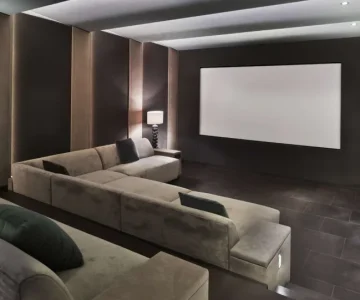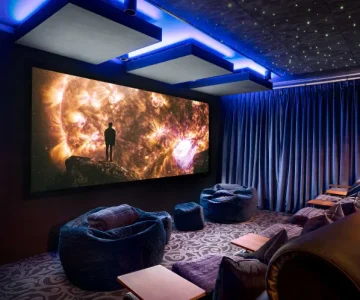Turning a room into a dedicated home cinema is an exciting way to blend technology, design, and a love for film. With the right planning and attention to detail, you can create an entertainment space that feels every bit as immersive as a commercial theatre.
Step 1: Laying the Groundwork
Before purchasing equipment, take time to map out your project. Select a space that can be darkened and insulated from outside noise—a spare room, attic, or converted basement often works well. Set a realistic budget, prioritising essentials such as the projector or television, sound system, seating, and acoustics, while reserving funds for décor and finishing touches.
If you want a professional-grade result, consider hiring installers who specialise in home cinemas. They can handle wiring, screen mounting, and system calibration, ensuring that your setup delivers optimal performance from day one.
Step 2: Planning the Design
The visual layout will have a major impact on your viewing experience. Choose a high-quality screen that suits your room size, paired with a projector capable of at least 1080p resolution—though 4K will provide superior clarity. Arrange seating to maintain a comfortable distance from the screen, typically 1.5 to 2.5 times its diagonal size.
Lighting is equally important. Install dimmable fixtures or concealed LED strips for ambient glow, add low-level task lighting for snack areas, and consider a smart control system so brightness can be adjusted with a remote or app.
Step 3: Selecting the Technology
A strong audio system is essential for recreating the cinematic atmosphere. Surround sound—especially with Dolby Atmos—adds depth and realism to the soundtrack. Invest in a reliable AV receiver, high-quality speakers, and subwoofers that suit your space. Good cables and proper cable management will also ensure a clean look and stable performance.
For ease of use, a home automation setup can control lighting, sound, and media sources from one interface, making it simple to switch between movie nights, gaming sessions, or music playback.
Step 4: Enhancing the Experience
Personal details help make the space your own. Wall-mounted movie posters, themed décor, or even a popcorn machine can capture the feeling of a real theatre. A refreshment corner with drinks and snacks keeps the experience self-contained and convenient.
Acoustic treatments are worth considering to improve sound quality. Panels, bass traps, and even soundproof curtains can reduce echoes and block unwanted noise, ensuring the focus stays on the film.
Step 5: Comfort Comes First
The seating you choose will define how enjoyable long screenings are. Recliners provide adjustability and personal space, while home theatre chairs offer dedicated features like cup holders and armrests. Sofas or sectionals can accommodate larger groups and create a relaxed, social environment. Leave adequate space between rows to allow for movement, and ensure every seat has an unobstructed view of the screen.
Step 6: Bringing It All Together
A well-designed home cinema isn’t just about technology—it’s about creating an environment that draws you into the story. From the first stages of planning to the final seat adjustment, each decision contributes to an experience that will be enjoyed for years.
Once the lights dim and the opening credits roll, you’ll have a space where family and friends can gather to share everything from blockbuster premieres to timeless classics—without ever leaving home.





